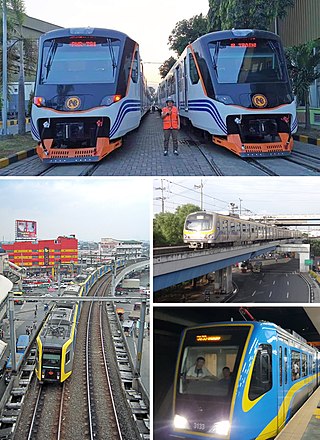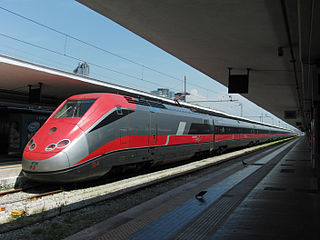
As the tenth-largest country in the world, and the largest in Africa and in the Mediterranean region, Algeria has a vast transportation system that includes a large and diverse transportation infrastructure.

Skikda is a city in northeastern Algeria and a port on the Mediterranean. It is the capital of Skikda Province and Skikda District.

The Nordland Line is a 729-kilometer (453 mi) railway line between Trondheim and Bodø, Norway. It is the longest in Norway and lacks electrification. The route runs through the counties of Trøndelag and Nordland, carrying a combination of commuter, long-haul passenger and freight trains. From Trondheim Central Station to Steinkjer Station the line is most heavily used, with hourly services by the Trøndelag Commuter Rail. There are three branch lines—the Stavne–Leangen Line at Leangen Station, the Meråker Line at Hell Station and the Namsos Line at Grong Station.

The Vestfold Line is a 137.79-kilometer (85.62 mi) railway line which runs between Drammen and Eidanger in Norway. The line connects to the Drammen Line at the northern terminus at Drammen Station and continues as the Bratsberg Line past Skien Station. The line is exclusively used for passenger trains, which are provided by Vy, which connect northwards to Oslo and south-westwards to Grenland. The 13-kilometer (8.1 mi) section from Eidanger to Skien is often colloquially included in the Vestfold Line.The standard gauge line is electrified at 15 kV 16.7 Hz AC and has twelve remaining stations. The Vestfold Line runs through the coastal region of Vestfold and serves major towns including Holmestrand, Tønsberg, Sandefjord and Larvik, as well as Sandefjord Airport, Torp.

Rail transportation in the Philippines is currently used mostly to transport passengers within Metro Manila and provinces of Laguna and Quezon, as well as a commuter service in the Bicol Region. Freight transport services once operated in the country, but these services were halted. However, there are plans to restore old freight services and build new lines. From a peak of 1,100 kilometers (680 mi), the country currently has a railway footprint of 533.14 kilometers (331.28 mi), of which only 129.85 kilometers (80.69 mi) are operational as of 2024, including all the urban rail lines. World War II, natural calamities, underspending, and neglect have all contributed to the decline of the Philippine railway network. In the 2019 Global Competitiveness Report, the Philippines has the lowest efficiency score among other Asian countries in terms of efficiency of train services, receiving a score of 2.4, and ranking 86th out of 101 countries globally. The government is currently expanding the railway network up to 1,900 kilometers (1,200 mi) by 2022 through numerous projects.

The Islamic Republic of Iran Railways is the national state-owned railway system of Iran. The Raja Passenger Train Company is an associate of the IR, and manages its passenger trains. The Railway Transportation Company is an associate of the IR, which manages its freight transport. The Ministry of Roads & Urban Development is the state agency that oversees the IRIR. Some 33 million tonnes of goods and 29 million passengers are transported annually by the rail transportation network, accounting for 9 percent and 11 percent of all transportation in Iran, respectively (2011).

The Jammu–Baramulla line is a railway track being laid to connect the Kashmir Valley in the Indian union territory of Jammu and Kashmir with Jammu railway station and thence to the rest of the country. The 338 km railway track will start from Jammu and end at Baramulla. It comes under the jurisdiction of the Firozpur railway division of Indian Railways' Northern zone. Part of this railway route from Udhampur to Baramulla is known as Udhampur-Srinagar-Baramula Rail Link (USBRL). The 359 m (1,178 ft) tall Chenab Bridge lies on this line, which is the tallest railway bridge in the world. The total project cost in 2022 was INR28,000 crore.

High-speed rail in Italy consists of two lines connecting most of the country's major cities. The first line connects Turin to Salerno via Milan, Bologna, Florence, Rome and Naples, the second runs from Turin to Venice via Milan and Verona, and is under construction in parts. Trains are operated with a top speed of 300 km/h (190 mph).

Rail transport plays a crucial role in connecting various regions of Thailand, transporting both goods and passengers through a range of transportation options that include inter-city and commuter rail, mass rapid transit, monorails, and airport rail links. The State Railway of Thailand (SRT) operates a network of intercity railways spanning 4,845.1 kilometers, covering 47 provinces across the country. SRT is committed to developing railway lands through its subsidiary, SRT Asset (SRTA), which focuses on transit-oriented development (TOD) initiatives. The Krung Thep Aphiwat Central Terminal in Bangkok serves as the primary transportation hub for rail transport in Thailand, connecting various types of rail transportation throughout the country. It covers an area of 274,192 square meters, making it the largest railway station in Southeast Asia, and is situated in a new central business district (CBD) that is currently being developed.

Railways in Nigeria consist of a 3,505 km Cape gauge national railway network and 669 km of standard gauge. The Cape gauge network is in poor condition due to lack of maintenance. In 2019, the single operational standard gauge line from Abuja to Kaduna generated as much revenue as the entire Cape gauge railway network combined. The Nigerian government plans to extend the standard gauge to replace most of the Western Line, while the Eastern Line will be rehabilitated as a Cape gauge line. All trains in Nigeria are operated by the Nigerian Railway Corporation.

The Algiers Metro is a rapid transit system that serves Algiers, the capital of Algeria. Originally designed in the 1970s, it opened in 2011 after decades of delays due to financial difficulties and security issues. The Algiers Metro was the second metro system to open in Africa, after the Cairo Metro.

The National Rail Transportation Company is Algeria's national railway operator. The SNTF, a state-owned company, currently has a monopoly over Algeria's rail network of 3,973 km (2,469 mi), although it is currently utilising only 3,572 km (2,220 mi). Out of the total railway network, 2,888 km (1,795 mi) are 1,435 mmstandard gauge and 1,085 km (674 mi) are 1,055 mm narrow gauge.

Ramdane Djamel is a town and commune in Skikda Province in north-eastern Algeria.
The Milan–Verona high-speed railway is an Italian 165-kilometre (103-mile) long high-speed railway line, that is partly open and partly under construction to connect Milan with Verona. The route operates through the regions of Lombardy and Veneto. The line is part of Railway axis 6 of the Trans-European rail network (TEN-T) on the Pan-European Corridor V. The line will replace the Milan–Venice railway for high-speed trains.

The Mindanao Railway, previously known as the Trans-Mindanao High Speed Railway, is a proposed inter-city rail system in Mindanao, the southernmost major island of the Philippines. Originally proposed in 1936 as part of Manuel L. Quezon's efforts to strengthen the presence of Commonwealth government in Mindanao against the rising influence of Imperial Japan before World War II, the line was shelved. Other proposals and studies were made in the 1950s, 1990s, and the 2000s, but never materialized. The current line began development in 2018; however, construction has yet to start. It will be initially built as a single-track standard gauge system to be operated by diesel-powered rolling stock, but will have provisions for upgrading to double-track and electrification through overhead lines.

The Koderma–Hazaribagh–Barkakana–Ranchi line is an Indian railway line connecting Koderma Junction in the Asansol–Gaya section with Hazaribagh Town, Barkakana and Ranchi. This 211-kilometre (131 mi) track is under the jurisdiction of South Eastern Railway and East Central Railway.

The Algiers-Oran Railway is one of the major components of the Algerian railway network. It links Algiers station with Oran. The first segment of the line, connecting Algiers with Blida opened on September 8, 1862 and was extended to Oran on May 1, 1871.

The Algiers-Skikda line is one of the two trunk lines in the Algerian railway network, the other being the Algiers-Oran line. The line hosts passenger services connecting Algiers station with either Annaba or Constantine, the two largest cities in eastern Algeria. The first segment of the line connected Constantine to the port of Skikda and opened on September 1, 1870, remaining isolated from the remainder of the Algerian network until the opening of the Algiers-Constantine segment in 1879 and further extensions on November 3, 1886.
The Béni Mansour-Béjaïa line is an Algerian railway connecting the Soummam River valley to the Algiers-Skikda line over 88 kilometers. The line was opened in full in 1899.


















